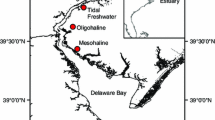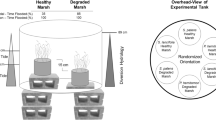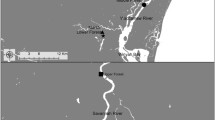Abstract
Tidal freshwater marshes exist in a dynamic environment where plant productivity, subsurface biogeochemical processes, and soil elevation respond to hydrological fluctuations over tidal to multi-decadal time scales. The objective of this study was to determine ecosystem responses to elevated salinity and increased water inputs, which are likely as sea level rise accelerates and saltwater intrudes into freshwater habitats. Since June 2008, in situ manipulations in a Zizaniopsis miliacea (giant cutgrass)-dominated tidal freshwater marsh in South Carolina have raised porewater salinities from freshwater to oligohaline levels and/or subtly increased the amount of water flowing through the system. Ecosystem-level fluxes of CO2 and CH4 have been measured to quantify rates of production and respiration. During the first 20 months of the experiment, the major impact of elevated salinity was a depression of plant productivity, whereas increasing freshwater inputs had a greater effect on rates of ecosystem CO2 emissions, primarily due to changes in soil processes. Net ecosystem production, the balance between gross ecosystem production and ecosystem respiration, decreased by 55% due to elevated salinity, increased by 75% when freshwater inputs were increased, and did not change when salinity and hydrology were both manipulated. These changes in net ecosystem production may impact the ability of marshes to keep up with rising sea levels since the accumulation of organic matter is critical in allowing tidal freshwater marshes to build soil volume. Thus, it is necessary to have regional-scale predictions of saltwater intrusion and water level changes relative to the marsh surface in order to accurately forecast the long-term sustainability of tidal freshwater marshes to future environmental change.




Similar content being viewed by others
References
Baldwin, A.H., and I.A. Mendelssohn. 1998. Effects of salinity and water level on coastal marshes: An experimental test of disturbance as a catalyst for vegetation change. Aquatic Botany 61: 255–268.
Baldwin, A.H., K.L. McKee, and I.A. Mendelssohn. 1996. The influence of vegetation, salinity, and inundation on seed banks of oligohaline coastal marshes. American Journal of Botany 83: 470–479.
Bartlett, K.B., D.S. Bartlett, R.C. Harriss, and D.I. Sebacher. 1987. Methane emissions along a salt marsh salinity gradient. Biogeochemistry 4: 183–202.
Bridgham, S.D., K. Updegraff, and J. Pastor. 1998. Carbon, nitrogen, and phosphorus mineralization in northern wetlands. Ecology 79: 1545–1561.
Burkett, V., R. Ritschard, S. McNulty, J.J. O'Brien, R. Abt, J. Jones, U. Hatch, B. Murray, S. Jagtop, and J. Cruise. 2001. Potential consequences of climate change variability and change for the southeastern United States. In Climate change impacts on the United States: The potential consequences of climate variability and change, 137–164. Cambridge: Cambridge University Press.
Cannell, M.G.R., and J.H.M. Thornley. 2000. Modelling the components of plant respiration: Some guiding principles. Annals of Botany 85: 45–54.
Cavalieri, A.J., and A.H.C. Huang. 1981. Accumulation of proline and glycinebetaine in Spartina alterniflora in response to NaCl and nitrogen in the marsh. Oecologia 49: 224–228.
Chapin III, F.S., G.M. Woodwell, J.T. Randerson, E.B. Rastetter, G.M. Lovett, D.D. Baldocchi, D.A. Clark, M.E. Harmon, D.S. Schimel, R. Valentini, C. Wirth, J.D. Aber, J.J. Cole, M.L. Goulden, J.W. Harden, M. Heimann, R.W. Howarth, P.A. Matson, A.D. McGuire, J.M. Melillo, H.A. Mooney, J.C. Neff, R.A. Houghton, M.L. Pace, M.G. Ryan, S.W. Running, O.E. Sala, W.H. Schlesinger, and E.-D. Schulze. 2006. Reconciling carbon-cycle concepts, terminology, and methods. Ecosystems 9: 1041–1050.
Childers, D.L., F.H. Sklar, B. Drake, and T. Jordan. 1993. Seasonal measurements of sediment elevation in three mid-Atlantic estuaries. Journal of Coastal Research 9: 986–1003.
Christensen, J.H., B. Hewitson, A. Busuioc, A. Chen, X. Gao, I. Held, R. Jones, R.K. Kolli, W.-T. Kwon, R. Laprise, V. Magaña Rueda, L. Mearns, C.G. Menéndez, J. Räisänen, A. Rinke, A. Sarr, and P. Whetton. 2007. Regional climate projections. In Climate change 2007: The physical science basis. Contribution of Working Group I to the Fourth Assessment Report of the Intergovernmental Panel on Climate Change, ed. S. Solomon, D. Qin, M. Manning, Z. Chen, M. Marquis, K.B. Averyt, M. Tignor, and H.L. Miller, 847–940. Cambridge: Cambridge University Press.
Conner, W.H., K.W. McLeod, and J.K. McCarron. 1997. Flooding and salinity effects on growth and survival of four common forested wetland species. Wetlands Ecology and Management 5: 99–109.
Correll, D.L., T.E. Jordan, and D.E. Weller. 1999. Transport of nitrogen and phosphorus from Rhode River watersheds during storm events. Water Resources Research 35: 2513–2521.
Craft, C.B. 2007. Freshwater input structures soil properties, vertical accretion, and nutrient accumulation of Georgia and U.S. tidal marshes. Limnology and Oceanography 52: 1220–1230.
Crowley, P.H. 1992. Resampling methods for computation-intensive data analysis in ecology and evolution. Annual Review of Ecology and Systematics 23: 405–447.
DeLaune, R.D., S.R. Pezeshki, and W.H. Patrick Jr. 1987. Response of coastal plants to increases in submergence and salinity. Journal of Coastal Research 3: 535–546.
Ensign, S.H., M.F. Piehler, and M.W. Doyle. 2008. Riparian zone denitrification affects nitrogen flux through a tidal freshwater river. Biogeochemistry 91: 133–150. doi:10.1007/s10533-008-9265-9.
Fenchel, T., and B.J. Finlay. 1995. Ecology and evolution in anoxic worlds. New York: Oxford University Press.
Freeman, C., N. Ostle, and H. Kang. 2001. An enzymatic ‘latch’ on a global carbon store. Nature 409: 149.
Glenn, E., T.L. Thompson, R. Frye, J. Riley, and D. Baumgartner. 1995. Effects of salinity on growth and evapotranspiration of Typha domingensis Pers. Aquatic Botany 52: 75–91.
Gornitz, V.S., S. Lebedeff, and J.E. Hansen. 1982. Global sea level trend in the past century. Science 215: 1611–1614.
Greiner La Peyre, M.K., J.B. Grace, E. Hahn, and I.A. Mendelssohn. 2001. The importance of competition in regulating plant species abundance along a salinity gradient. Ecology 82: 62–69. doi:10.1890/0012-9658(2001)082[0062:TIOCIR]2.0.CO;2.
Hilton, T.W., R.G. Najjar, L. Zhong, and M. Li. 2008. Is there a signal of sea-level rise in Chesapeake Bay salinity? Journal of Geophysical Research 113: C09002. doi:10.1029/2007/JC004247.
Jackson, M.B., and M.C. Drew. 1984. Effects of flooding on growth and metabolism of herbaceous plants. In Flooding and plant growth, ed. T.T. Kozlowski, 47–128. New York: Academic.
Kelley, B.J. 2009. South Carolina rice fields. http://www.citadel.edu/computing/mm/test/cb/survey/index.html. Accessed 09 Aug 2009.
Kelley, B.J., and R.D. Porcher. 1995. Vegetational status of the freshwater tidal marshes of the upper Cooper River. Charleston: South Carolina Department of Health and Environmental Control, Office of Coastal Resource Management.
Koch, M.S., I.A. Mendelssohn, and K.L. McKee. 1990. Mechanism for the hydrogen sulphide-induced growth limitation in wetland macrophytes. Limnology and Oceanography 35: 399–408.
Krauss, K.W., J.L. Chambers, and D. Creech. 2007. Selection for salt tolerance in tidal freshwater swamp species: Advances using baldcypress as a model for restoration. In Ecology of tidal freshwater forested wetlands of the southeastern United States, ed. W.H. Conner, T.W. Doyle, and K.W. Krauss, 385–410. The Netherlands: Springer.
Krauss, K.W., T.W. Doyle, and R.J. Howard. 2009a. Is there evidence of adaptation to tidal flooding in saplings of baldcypress subjected to different salinity regimes? Environmental and Experimental Botany 67: 118–126.
Krauss, K.W., J.A. Duberstein, T.W. Doyle, W.H. Conner, R.H. Day, L.W. Inabinette, and J.L. Whitbeck. 2009b. Site condition, structure, and growth of baldcypress along tidal/non-tidal salinity gradients. Wetlands 20: 505–519.
Kuzyakov, Y., and W. Cheng. 2001. Photosynthesis controls of rhizosphere respiration and organic matter decomposition. Soil Biology and Biochemistry 33: 1915–1925.
Lamers, L.P.M., H.B.M. Tomassen, and J.G.M. Roelofs. 1998. Sulfate-induced eutrophication and phytotoxicity in freshwater wetlands. Environmental Science and Technology 32: 199–205.
Latham, P.J., L.G. Pearlstine, and W.M. Kitchens. 1994. Species association changes across a gradient of fresh-water, oligohaline, and mesohaline tidal marshes along the lower Savannah River. Wetlands 14: 174–183.
Leck, M.A., A.H. Baldwin, V.T. Parker, L. Schile, and D.F. Whigham. 2009. Plant communities of tidal freshwater wetlands of the continental USA and southeastern Canada. In Tidal freshwater wetlands, ed. A. Barendregt, D.F. Whigham, and A.H. Baldwin, 41–58. Leiden: Backhuys.
Lovett, G.M., J.J. Cole, and M.L. Pace. 2006. Is net ecosystem production equal to ecosystem carbon accumulation? Ecosystems 9: 152–155.
McKee, K.L., and I.A. Mendelssohn. 1989. Response of a freshwater marsh plant community to increased salinity and increased water level. Aquatic Botany 34: 301–316.
Meehl, G.A., T.F. Stocker, W.D. Collins, P. Friedlingstein, A.T. Gaye, J.M. Gregory, A. Kitoh, R. Knutti, J.M. Murphy, A. Noda, S.C.B. Raper, I.G. Watterson, A.J. Weaver, and Z.-C. Zhao. 2007. Global climate projections. In Climate change 2007: The physical science basis. Contribution of Working Group I to the Fourth Assessment Report of the Intergovernmental Panel on Climate Change, ed. S. Solomon, D. Qin, M. Manning, Z. Chen, M. Marquis, K.B. Averyt, M. Tignor, and H.L. Miller, 747–845. Cambridge: Cambridge University Press.
Megonigal, J.P., and S.C. Neubauer. 2009. Biogeochemistry of tidal freshwater wetlands. In Coastal wetlands: An integrated ecological approach, ed. G.M.E. Perillo, E. Wolanski, D.R. Cahoon, and M.M. Brinson, 535–562. Amsterdam: Elsevier.
Megonigal, J.P., and W.H. Schlesinger. 1997. Enhanced CH4 emissions from a wetland soil exposed to elevated CO2. Biogeochemistry 37: 77–88.
Megonigal, J.P., M.E. Hines, and P.T. Visscher. 2004. Anaerobic metabolism: linkages to trace gases and aerobic metabolism. In Biogeochemistry, ed. W.H. Schlesinger, 317–424. Oxford: Elsevier-Pergamon.
Mendelssohn, I.A., and J.T. Morris. 2000. Eco-physiological controls on the productivity of Spartina alterniflora Loisel. In Concepts and controversies in tidal marsh ecology, ed. M. Weinstein and D.A. Kreeger, 59–80. Dordrecht: Kluwer Academic.
Miller, W.D., S.C. Neubauer, and I.C. Anderson. 2001. Effects of sea level induced disturbances on high salt marsh metabolism. Estuaries 24: 357–367.
Morris, J.T. 1995. The mass balance of salt and water in intertidal sediments: Results from North Inlet, South Carolina. Estuaries 18: 556–567.
Morris, J.T. 2000. Effects of sea-level anomalies on estuarine processes. In Estuarine science: A synthetic approach to research and practice, ed. J. Hobbie, 107–127. Washington, DC: Island.
Morris, J.T., P.V. Sundareshwar, C.T. Nietch, B. Kjerfve, and D.R. Cahoon. 2002. Responses of coastal wetlands to rising sea level. Ecology 83: 2869–2877.
Munns, R., and M. Tester. 2008. Mechanisms of salinity tolerance. Annual Review of Plant Biology 59: 651–681. doi:10.1146/annurev.arplant.59.032607.092911.
Neubauer, S.C. 2008. Contributions of mineral and organic components to tidal freshwater marsh accretion. Estuarine, Coastal and Shelf Science 78: 78–88.
Neubauer, S.C., and I.C. Anderson. 2003. Transport of dissolved inorganic carbon from a tidal freshwater marsh to the York River estuary. Limnology and Oceanography 48: 299–307.
Neubauer, S.C., and C.B. Craft. 2009. Global change and tidal freshwater wetlands: Scenarios and impacts. In Tidal freshwater wetlands, ed. A. Barendregt, D.F. Whigham, and A.H. Baldwin, 253–266. Leiden: Backhuys.
Neubauer, S.C., W.D. Miller, and I.C. Anderson. 2000. Carbon cycling in a tidal freshwater marsh ecosystem: A carbon gas flux study. Marine Ecology Progress Series 199: 13–30.
Neubauer, S.C., I.C. Anderson, J.A. Constantine, and S.A. Kuehl. 2002. Sediment deposition and accretion in a mid-Atlantic (U.S.A.) tidal freshwater marsh. Estuarine. Coastal and Shelf Science 54: 713–727.
Neubauer, S.C., K. Givler, S. Valentine, and J.P. Megonigal. 2005. Seasonal patterns and plant-mediated controls of subsurface wetland biogeochemistry. Ecology 86: 3334–3344.
Nietch, C.T. 2000. Carbon biogeochemistry in tidal marshes of South Carolina: The effect of salinity and nutrient availability on marsh metabolism in estuaries with contrasting histories of disturbance and river influence. Ph.D. dissertation. University of South Carolina, Columbia, South Carolina.
NOAA-NERRS. 2010. National Oceanic and Atmospheric Administration, Office of Ocean and Coastal Resource Management, National Estuarine Research Reserve System-wide Monitoring Program. http://cdmo.baruch.sc.edu. Accessed 12 January 2010.
Nyman, J.A., and R.D. DeLaune. 1991. CO2 emission and soil Eh responses to different hydrological conditions in fresh, brackish, and saline marsh soils. Limnology and Oceanography 36: 1406–1414.
Odum, W.E. 1988. Comparative ecology of tidal freshwater and salt marshes. Annual Review of Ecology and Systematics 19: 147–176.
Odum, W.E., T.J. Smith III, J.K. Hoover, and C.C. McIvor. 1984. The ecology of tidal freshwater marshes of the United States east coast: A community profile. FWS/OBS-83/17. Washington, DC: U.S. Fish and Wildlife Service.
Orson, R.A., R.L. Simpson, and R.E. Good. 1992. The paleoecological development of a late Holocene, tidal freshwater marsh of the upper Delaware estuary. Estuaries 15: 130–146.
Parker, V.T., and M.A. Leck. 1985. Relationships of seed banks to plant distribution patterns in a freshwater tidal wetland. American Journal of Botany 72: 161–174.
Pasternack, G.B. 2009. Hydrogeomorphology and sedimentation in tidal freshwater wetlands. In Tidal freshwater wetlands, ed. A. Barendregt, D.F. Whigham, and A.H. Baldwin. Leiden: Backhuys.
Patchineelam, S.M., B. Kjerfve, and L.R. Gardner. 1999. A preliminary sediment budget for the Winyah Bay estuary, South Carolina, USA. Marine Geology 162: 133–144.
Pearlstine, L.G., W.M. Kitchens, P.J. Latham, and R.D. Bartleson. 1993. Tide gate influences on a tidal marsh. Water Resources Bulletin 29: 1009–1019.
Perry III, J.E., and C. Hershner. 1999. Temporal changes in the vegetation pattern in a tidal freshwater marsh. Wetlands 19: 90–99.
Peterson, J.E., and A.H. Baldwin. 2004. Seedling emergence from seed banks of tidal freshwater wetlands: Response to inundation and sedimentation. Aquatic Botany 78: 243–254.
Pezeshki, S.R. 2001. Wetland plant responses to soil flooding. Environmental and Experimental Botany 46: 299–312. doi:10.1016/S0098-8472(01)00107-1.
Pezeshki, S.R., R.D. Delaune, and W.H. Patrick. 1987a. Effects of flooding and salinity on photosynthesis of Sagittaria lancifolia. Marine Ecology Progress Series 41: 87–91.
Pezeshki, S.R., R.D. DeLaune, and W.H. Patrick Jr. 1987b. Response of the freshwater marsh species, Panicum hemitomon Schult., to increased salinity. Freshwater Biology 1: 195–200.
Ponnamperuma, F.N. 1984. Effects of flooding on soils. In Flooding and plant growth, ed. T.T. Kozlowski, 9–45. New York: Academic.
Pont, D., J.-P. Simonnet, and A.V. Walter. 2002. Medium-term changes in suspended sediment delivery to the ocean: Consequences of catchment heterogeneity and river management (Rhône River, France). Estuarine, Coastal and Shelf Science 54: 1–18. doi:10.1006/ecss.2001.0829.
Reay, W.G. 1989. Subsurface hydrodynamics and nutrient exchange within an extensive tidal freshwater wetland. Ph.D. dissertation. College of William and Mary, Virginia Institute of Marine Science.
Redfield, A.C. 1965. Ontogeny of a salt marsh estuary. Science 147: 50–55.
Roulet, N.T., and T.R. Moore. 1995. The effect of forestry drainage practices on the emissions of methane from northern peatlands. Canadian Journal of Forest Research 25: 491–499.
Schlesinger, W.H. 1997. Biogeochemistry: An analysis of global change. San Diego: Academic.
Schuyler, A.E., S.B. Andersen, and V.J. Kolaga. 1993. Plant zonation in the tidal portion of the Delaware River. Proceedings of the Academy of Natural Sciences of Philadelphia 144: 263–266.
Spalding, E.A., and M.W. Hester. 2007. Interactive effects of hydrology and salinity on oligohaline plant species productivity: Implications of relative sea-level rise. Estuaries and Coasts 30: 214–225.
Tufford, D.L. 2005. State of knowledge: South Carolina coastal wetland impoundments. Charleston: South Carolina Sea Grant Consortium.
Tzortziou, M., P.J. Neale, C.L. Osburn, J.P. Megonigal, N. Maie, and R. Jaffé. 2008. Tidal marshes as a source of optically and chemically distinctive colored dissolved organic matter in Chesapeake Bay. Limnology and Oceanography 53: 148–159.
Updegraff, K., S.D. Bridgham, J. Pastor, P. Weishampel, and C. Harth. 2001. Response of CO2 and CH4 emissions from peatlands to warming and water table manipulation. Ecological Applications 11: 311–326.
Valentine, D.L., E.A. Holland, and D.S. Schimel. 1994. Ecosystem and physiological controls over methane production in northern wetlands. Journal of Geophysical Research 99: 1563–1571. doi:10.1029/93JD00391.
van der Nat, F.-J., and J.J. Middelburg. 2000. Methane emission from tidal freshwater marshes. Biogeochemistry 49: 103–121.
Vann, C.D., and J.P. Megonigal. 2003. Elevated CO2 and water depth regulation of methane emissions: Comparison of woody and non-woody wetland plant species. Biogeochemistry 63: 117–134.
Weston, N.B., R.E. Dixon, and S.B. Joye. 2006. Ramifications of increased salinity in tidal freshwater sediments: Geochemistry and microbial pathways of organic matter mineralization. Journal of Geophysical Research 111: G01009. doi:10.1029/2005JG000071.
Weston, N.B., M.A. Vile, S.C. Neubauer, and D.J. Velinsky. 2011. Accelerated microbial organic matter mineralization following salt-water intrusion into tidal freshwater marsh soils. Biogeochemistry 102: 135–151. doi:10.1007/s10533-010-9427-4.
Wetzel, P.R., W.M. Kitchens, J.M. Brush, and M.L. Dusek. 2004. Use of a reciprocal transplant study to measure the rate of plant community change in a tidal marsh along a salinity gradient. Wetlands 24: 879–890.
Whiting, G.J., and J.P. Chanton. 1993. Primary production control of methane emission from wetlands. Nature 364: 794–795.
Whiting, G.J., D.S. Bartlett, S. Fan, P.S. Bakwin, and S.C. Wofsy. 1992. Biosphere/atmosphere CO2 exchange in tundra ecosystems: Community characteristics and relationships with multispectral surface reflectance. Journal of Geophysical Research 97: 16671–16680.
Willis, J.M., and M.W. Hester. 2004. Interactive effects of salinity, flooding, and soil type on Panicum hemitomon. Wetlands 24: 43–50.
Acknowledgments
I thank Liana Nichols, Paul Kenny, Tom Marshall, Shan Deeter, Christina Mitchell, Leigh McCallister, Lindsey Koren, and Troy Washum for invaluable assistance in the field; Stephen Forehand for help constructing the flux chambers and collars; and Michelle, Isabella, and Ryleigh Neubauer and Dorothy Silvernail for help constructing the porewater samplers. Erik Smith and Amy Willman helped access weather data. I especially thank Bob Jewell, Mike Ammons, and the staff at Brookgreen Gardens for allowing and facilitating access to the study site. This research was supported by a grant from the University of South Carolina, Office of Research and Health Sciences Research Funding Program to S.C.N. The weather data were collected by staff at the North Inlet—Winyah Bay National Estuarine Research Reserve under an award from the Estuarine Reserves Division, Office of Ocean and Coastal Resource Management, National Ocean Service, National Oceanic and Atmospheric Administration. This is contribution number 1633 from the University of South Carolina’s Belle W. Baruch Institute for Marine and Coastal Sciences.
Author information
Authors and Affiliations
Corresponding author
Rights and permissions
About this article
Cite this article
Neubauer, S.C. Ecosystem Responses of a Tidal Freshwater Marsh Experiencing Saltwater Intrusion and Altered Hydrology. Estuaries and Coasts 36, 491–507 (2013). https://doi.org/10.1007/s12237-011-9455-x
Received:
Revised:
Accepted:
Published:
Issue Date:
DOI: https://doi.org/10.1007/s12237-011-9455-x




